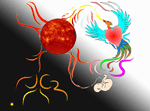But Jesus said,
« Let the little children come to me, and do not hinder them, for the kingdom of heaven belongs to such as these. » Matthew 19:14 Mark 10:14 |
The birth
of the healthy mind.
of the healthy mind.
Preamble :
Some may say that we are taking a long time to get into the realm of dreams.
But it is necessary to understand why our dreams escape us.. They are indeed the expression of an inner intelligence, of an instinctive thought which has the intuitive knowledge of what is good for us, but which our mind rejects, under the influence of collective rules.
On the other hand, couldn't the statement that "the kingdom of heaven belongs to children" [NdA] help us to find, through the study of the stages of development of the little man and his brain, elements of response to our research ?
While human beings, in their great majority, designate themselves as belonging to a superior species, if not a "chosen" species, even today, children are far from being recognized for their real capacities, when they are not simply treated as slaves. Ancient writings describing their status within the human community have sometimes frozen their place. The Bible has, in this sense, left its mark.
A boy is always a gift from God (Psalms 127.3), but the child possesses [cf : The child in the biblical world ], from birth, the defects of the adult human being : « Who can bring what is pure from the impure? No one ! » (Job 14.4).
For the sapiential authors, children must therefore be severely educated (Proverbs 13,24 ; 22,15 ; Sirach 30,1-13).
However, 2000 years ago, a man named Jesus of Nazareth expressed a new idea : children were no longer to be discarded. On the contrary, they were models to be imitated : « Let the little children come to me, and do not hinder them, for the kingdom of God belongs to such as these. » (Mark 10.14).
Today, scientists are discovering abilities in this child that, until then, no one would have dared to acknowledge.
What do we know about him, and what do we know about his intelligence ?
By what developmental processes does the little man manage to exercise it ?
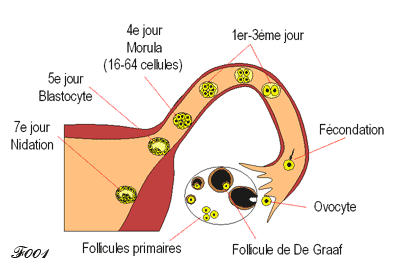
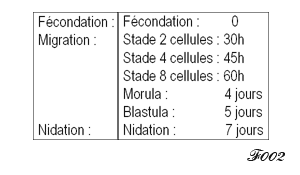
2nd week : development of the embryo.
From the 8th day, the embryo begins to organize itself, constituting two poles (head - tail).
Then, a cellular thickening appears on the dorsal face of the embryonic disc, the primitive line, which extends on the two thirds of its length. This line will determine the longitudinal axis of the embryo.
At the end of the second week, the symmetry of the embryo is achieved.
During the fourth week, the neural gutter, formed by the digging of the primitive line, closes, constituting the neural tube, at the origin of the nervous system.
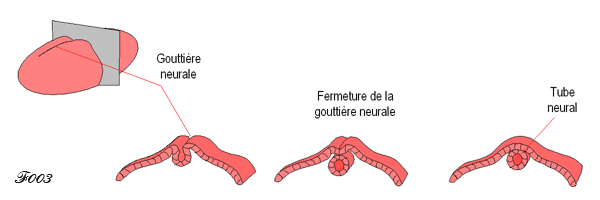
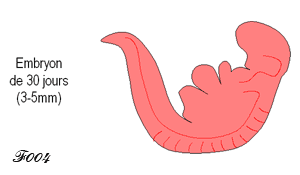
The neural tube will then give birth to three primary vesicles (prosencephalon, mesencephalon, rhombencephalon) which will later divide into five secondary vesicles (telencephalon, diencephalon, mesencephalon, metencephalon and myelencephalon) at the origin of the brain and the medulla oblongata.
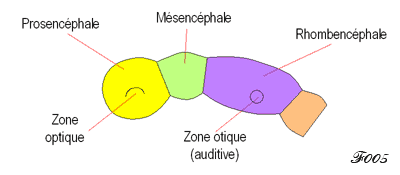

During the 5th week, excrescences appear on both sides of the body, outlines of the future members.
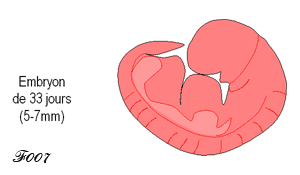
At the seventh week, one can distinguish the fingers of the hands, as well as the principal components of the face : eyes, eyelids, mouth, nose, and ears.
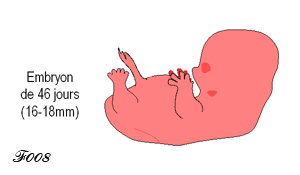
During the 2nd month, the production of neurons accelerates, reaching up to 5000 neurons per second.
At 2 months and a half : The cerebral hemispheres, derived from the telencephalon, are visible from the first ultrasound.
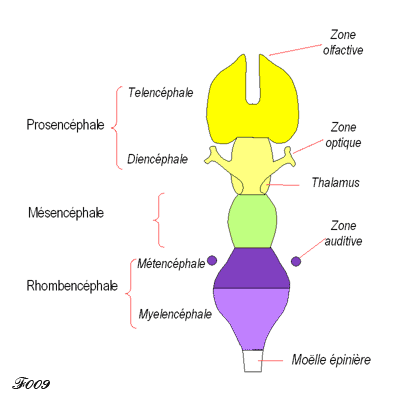
It is at this time that the brain shows signs of activity.
From the 8th week of development, the embryo is sufficiently developed to be called a fetus : at this stage, all the organ outlines are formed.
It measures approximately 35 mm and its first movements are visible on the ultrasound.
At the end of the 3rd month (12e semaine), the first measurable signs of electroencephalographic activity appear.
At the 5th month (20th week) the first auditory and tactile reactions reveal this nervous activity.
Although functional, the cortex is far from being completed. The connections between neurons (synapses) are in excess.
The spinal cord is becoming myelinated.
At the 6th month, the furrows and convolutions of the cerebral cortex appear. The growth cones of the neuronal axons move towards their target neuron, while the Schwann cells surround the axons with a myelin sheath.
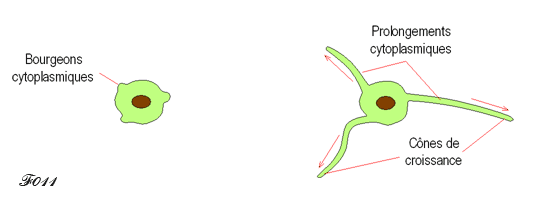
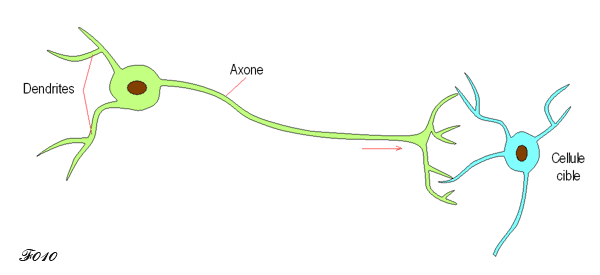
During the 7th month, lthe sense organs develop and the movements become more coordinated : the nervous system is perfecting.
Once genetic development is complete, learning will determine which neurons will live or die. The connections that are not used will degenerate after birth. The brain will then lose a third of its 100 billion neurons.
Myelination, which is responsible for the rapid increase in brain weight, continues until the age of four.
The fetus grows in an environment where a multitude of noises reign permanently : first of all sounds of maternal origin such as gastrointestinal noises, the beating of the heart or breathing, the vibrations of the maternal vocal cords ; but also external noises : maternal voice and various sounds coming from the environment.
The background noise in which the fetus is immersed is around 30 to 60 dB SPL (Sound Pressure Level), which is close to our own level.
However, during the first weeks of gestation, these sounds have no impact, because the auditory system of the fetus is not sufficiently developed to be functional.
It is not until the 7th month (la 28e semaine) that the fetus begins to react to a loud external sound (a level equivalent to the sound of a jackhammer, i.e. 110 dB SPL), emitted near its mother.
It is during the eighth month that its hearing is refined and that its auditory system can differentiate between high and low sounds.
It is therefore only when the fetus is nearing term that it can hear external voices, provided that the sound level exceeds the 80 dB SPL corresponding to the voice of a comedian on stage.
Shortly before birth it hears frequencies between 1000 and 3000 Hertz for a sound level of 60 dB SPL.
b - His body :
Devoid of a cerebral nervous system and functional senses during the first months of development, the fetus is certainly not aware of its environment. The first thing that is put in place is its own body.
Indeed, from the first month it begins to move; these movements, of reflex origin, exercise its muscles and joints.
However, it is not until the third quarter (when his nervous system is sufficiently developed) that these movements become more coordinated.
For that, the vestibular system of the ear shows its importance. Consisting of a vestibule (sensitive to linear accelerations), and semicircular canals (sensitive to angular accelerations), this system is ready to function from the 32nd week: it allows the fetus to adapt its posture.
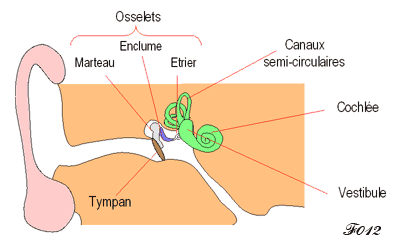
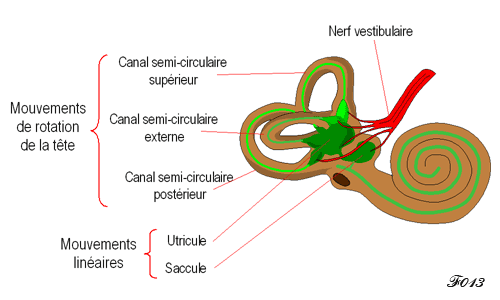
c - Smell :
Although its olfactory system (receptors and bulbs) is in place since the 8th week, the fetus starts to perceive the odorous molecules which arrive to him via the amniotic liquid only during the last months of gestation.
In fact, observations made in maternity wards had shown that the smell of the amniotic fluid of mothers who had eaten spicy food was very spicy.
These observations were confirmed in 2000, when an experiment conducted at the European Center of Taste Sciences (Dijon) by the team of Benoist Schaal and his collaborators, showed that a newborn whose mother had consumed aniseed during the last months of her pregnancy recognized this smell at birth and even showed signs of preference.
d - Sight :
The last sense to develop, sight is the sense that is least stimulated in the intrauterine environment.
During the 7th month, the eyelids open, the eyeballs move, but the visual system and in particular the development of the photo-receptor cells of the retina is incomplete.
In 1980, experiments carried out by Peleg and Goldman, during an amnioscopy, made it possible to observe that an illumination caused accelerations of the cardiac rhythm in the fetus. More recently, researchers from the University of Arkansas have also shown, by magnetoencephalography, that the fetus was sensitive to luminous fluxes when these were emitted outside the belly.
However, apart from variations in light intensity, it is very difficult to know what a fetus perceives in the maternal womb.
e - Memory :
If the physical development of the fetus is relatively easy to follow, its memory raises more questions. It seems to be established that we have no memory of our first two or three years of life and even more so of our fetal life : this is called infantile amnesia.
However, it has been observed that at the end of gestation the fetal brain memorizes elements of intrauterine life: maternal voice, smells, taste memories...
Moreover, clinical observation shows that in situations of major stress, adults can assume postures directly related to painful events suffered just after their birth : for example, a child who regularly plays hangman and whose anamnesis reveals that he was born with the umbilical cord around his neck.
Sensations experienced during the perinatal period would therefore have been memorized: they could resurface later in a totally different context.
Today, even if it is established that there are several cerebral structures involved in memory in the fetus, it is not certain that they are functional: this is what would explain infantile amnesia.
To understand this, it is necessary to know how a mature memory functions.
In adults, the information received by the brain is subjected to a double processing :
- a first very rapid processing, called analogical, during which the neurons put the information in memory, without classifying it. For this reason, they are difficult to recover in conscious processing.
- then, a second slower processing, qualified as cognitive, isolates the information from its context, then gives it a meaning, before storing it... It is this classification which makes it accessible to the consciousness.
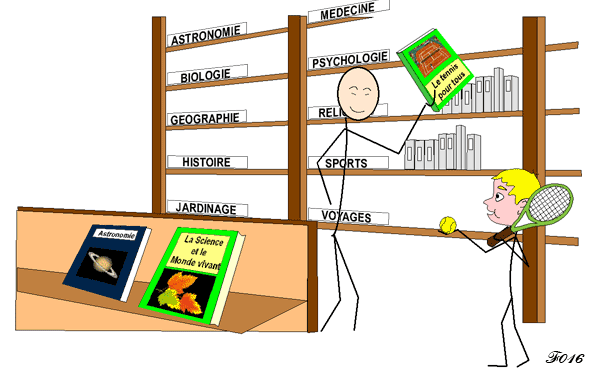
Associations can then be found between various events or objects, as well as links deferred in time, allowing the recall of a past situation.
This processing requires the involvement of elements (prefrontal cortex, modulator neurons) that are not yet fully developed in the fetus and the newborn (the frontal cortex continues to mature until the age of four). The fetus can therefore begin to store analogical knowledge, but it is not yet ready to classify it cognitively, because it does not yet have access to the reality of the external world.
This hypothesis does not mean that there are no memories acquired during the fetal period, but these are reduced to diffuse sensations that the adult cannot access later in a controlled way.
What can happen if we imagine that these memories stored in analogy one day pass into cognitive mode and become accessible ?
In this case, the memory will be recalled, but it will remain excluded from its original context: it will be inserted into a new context, that of the life of the adult subject. It is then probable that the interpretation given to the memory will be false, because this memory will be reconstructed according to the subject's beliefs or the parents' story. This is the case of adults who are certain to have seen their mother dressed in a red shirt, even though the notion of color did not exist for them during the first hours of life.
Vision is formed by learning. Adults can evoke memories because they transpose them into the reality they have learned to recognize. But if these memories belong to the perinatal period, he will reconstruct them from his current knowledge or beliefs : thus, a cry heard during the foetal period, without being placed in the objective visual or tactile reality will be able to be integrated into a belief in invisible spirits, whose manifestations we can hear.
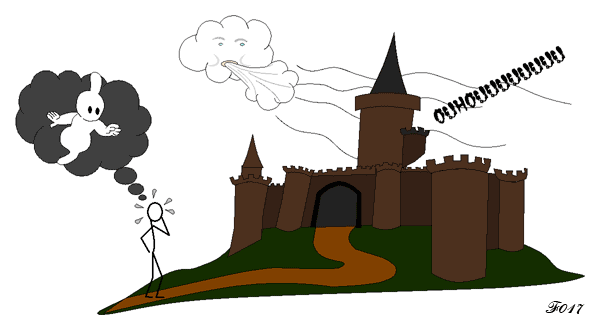
In the same way, in certain states of relaxation, the appearance of a visual image of a presence in a dark cave can be assimilated to the memory, either of the uterine life, or of a previous life, that of a prehistoric man for example.
It is also in this way that, by analogy with the transition from darkness to light experienced at birth, the "experience" of a subject near death (NDE) could be explained.
To be certain of recalling true memories, it is therefore necessary to focus on life events dating from a period when the cognitive processing of information was functional, which cannot be less than several semesters after birth.
A change takes place during the 7th month (27 weeks): the very first signs of a "restless" sleep or seismic sleep, (the equivalent of our REM sleep), gradually appear in the fetus. Eye movements become rapid, while arms and legs become slightly agitated. During this sleep, the breathing rhythm is very irregular. The duration of this restless sleep will progressively increase until birth, participating in the development of nerve cells: this is called fetal construction sleep.
At 29 weeks, a new stage: at the end of the seventh month, a third phase of sleep is required, the calm sleep, equivalent to the slow wave sleep of the adult, during which the fetus moves very little..
During the eighth month, the three sleep phases - indeterminate, restless and calm - now follow each other in a regular 50-minute cycle. Thus, in the ninth month, restless sleep occupies about 65% of the time, calm sleep 25%, and indeterminate sleep 10%. By the way, we will notice that the sleep of the fetus is not influenced by the sleep-wake rhythm of the mother.
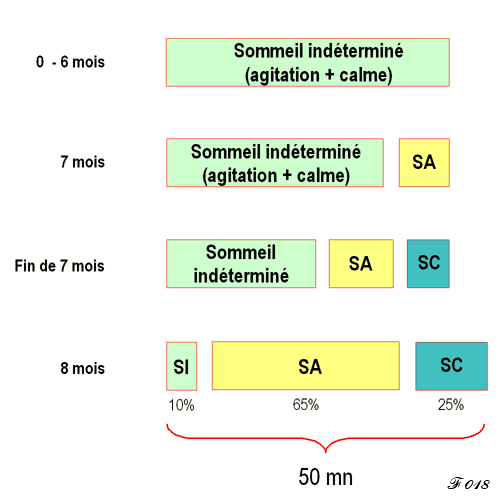
It is shortly before birth that the fetus will start to wake up : it opens its eyes for the first time. After birth, by inserting itself into the alternation of day and night, its biological rhythms will be transformed (cf : The phases of sleep in adults).
If the cerebral activity of the fetus sleep includes a phase similar to the paradoxical sleep of the adult, can we affirm that the fetus dreams? As the fetus is not yet able to relate sounds and smells to real objects or events, it is unlikely that its brain produces images such as those of an adult during a dream. This would require a capacity for symbolic representation, which does not appear before the age of eight. However, we notice that his phase of agitated sleep (the equivalent of REM sleep during which dreams take place), occupies, shortly before the term, a very important part of his sleep.
One can imagine that this type of sleep serves to structure the movements which, later, during the REM sleep of the adult, will be inhibited.
On the other hand, in adults for whom the memorization of events and lived experiences is important, it is the duration of the slow wave sleep (equivalent of the calm sleep) which will be the most important: it is indeed during this slow wave sleep that the general memory will be organized.
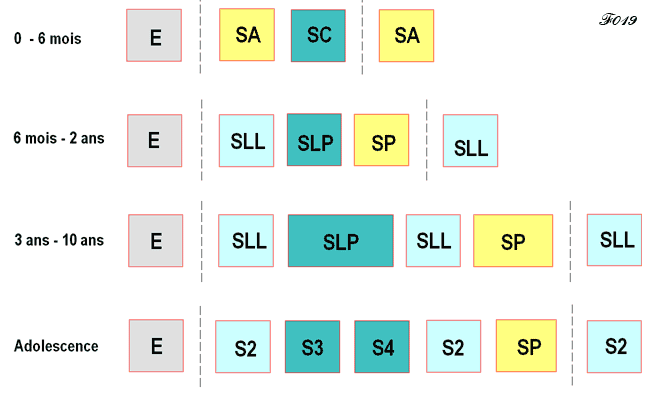
Some phrases cross the centuries and still remain relevant today.
Why have they left such a mark on the imagination ? Do they conceal a truth that speaks to the hearts of men ?
If this is so, why is this truth so little heard ?
Our purpose today will be to understand why this sentence has a value that our rationality cannot dismiss, even though it has never really been able to grasp its meaning.
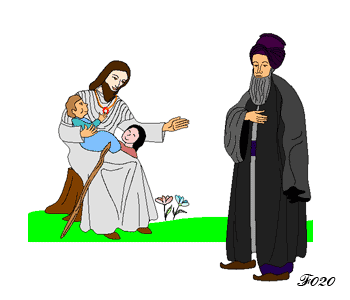 Intelligence, an essential function of the central nervous system, is the capacity to process, in a precise way, categories of information or data coming from the surrounding environment.
Intelligence, an essential function of the central nervous system, is the capacity to process, in a precise way, categories of information or data coming from the surrounding environment.
Thus, if we hear sounds, we will analyze them in a linguistic or musical way.
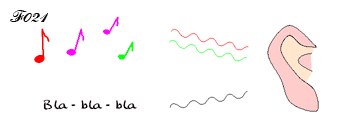 In the same way, our capacity to move in a variable environment will reveal a spatial intelligence.
In the same way, our capacity to move in a variable environment will reveal a spatial intelligence.
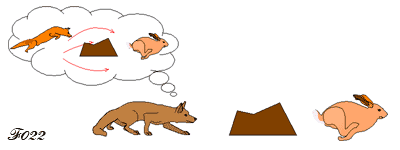
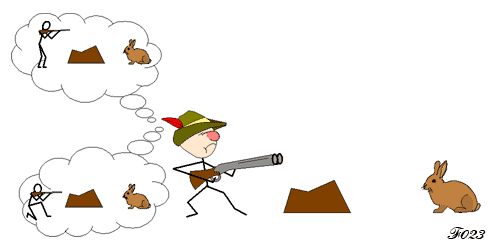
To understand intelligence, we can compare it to a computer assigned to specific tasks.
As a result, up to eight types of intelligence have been defined and assessed by intelligence quotient (IQ) tests.
However, while IQ tests are useful in psychology or job recruitment, their numerical results only indicate the number of questions that the interviewee answered correctly. We can learn more by observing how the subject approaches the questions.
Take the example of a child who, during a test, is asked the question: "You buy six apples at the market, you lose four on the way home. How many are left? ".
And who answers: "I can't lose four, because my father would punish me! ".
Is this answer wrong? Doesn't it rather show that there are two main types of intelligence, one linked to learning, and the other to sensitive perception.
Wouldn't intelligence be rather the capacity to adapt to any situation?
For a better understanding, we will therefore consider it under these two aspects: a conceptual intelligence (linked to thought contents separated from the reality of things) and a pragmatic intelligence (linked to the necessities of life).
Thus, in the preceding example, one will observe :
- under its intellectual aspect, a logical calculation which describes a virtual reality partially independent of the objective reality,
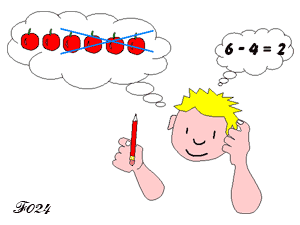 - in its practical aspect, we will obtain a concrete answer to the question asked, an answer that is included in a wider context: in the example proposed, it involves the existence of the father and his reaction, and it even underlies the whole family unit: "there are three of us and there will only be two apples left for dessert".
- in its practical aspect, we will obtain a concrete answer to the question asked, an answer that is included in a wider context: in the example proposed, it involves the existence of the father and his reaction, and it even underlies the whole family unit: "there are three of us and there will only be two apples left for dessert".
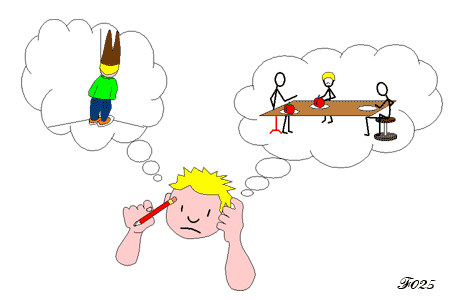 Intelligence cannot be summed up in only one of these aspects : if the intellectual aspect seems to be man's own, practical intelligence is all living beings'own, and it begins from the moment when one of them reacts in accordance with the necessities of life.
Intelligence cannot be summed up in only one of these aspects : if the intellectual aspect seems to be man's own, practical intelligence is all living beings'own, and it begins from the moment when one of them reacts in accordance with the necessities of life.
In man, this intelligence has for support the whole of his five senses [cf : L’édifice de la conscience].
Intelligence would thus be the capacity to listen and to analyze information, concrete or virtual, the final result being perceived pleasantly (one will then wish to use it) or unpleasantly (and in this case one will avoid it).
It can be useful to distinguish the different types of intelligence in order to study them better (cf: the eight intelligences). However, the set of characteristics that evolution has selected belongs to a "global intelligent system" that is indispensable both for the exercise of consciousness and for survival in a hostile environment.
In this sense, all living species are capable of "awareness", to detect food or the presence of predators.
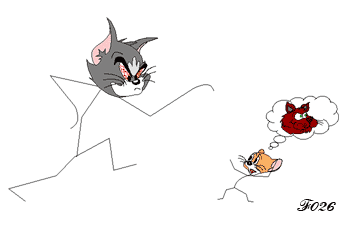
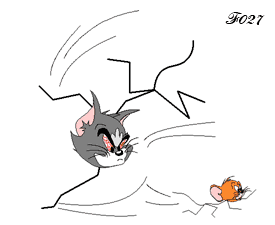 In the absence of predators (if we exclude bacteria), this ability to discover the environment has become less essential in humans. However, it has been preserved in the form we know, which is the characteristic of children : curiosity.
In the absence of predators (if we exclude bacteria), this ability to discover the environment has become less essential in humans. However, it has been preserved in the form we know, which is the characteristic of children : curiosity.
This need to know, that we can qualify of "instinctive", is the one that we find from the beginning of the development of the intelligence, indissociable of the capacity of analysis, indissociable of the conscience which is also, in the man, the capacity to know that he exists in the environment.
 Also, as it seems natural to locate the processes characterizing intelligence at the level of the brain, it is to this organ that we will be interested.
Also, as it seems natural to locate the processes characterizing intelligence at the level of the brain, it is to this organ that we will be interested.
To understand how the brain develops and to grasp the successive stages of its development is essential to approach the functioning of thought, and to determine how it has one day dissociated itself between rationality and sensibility.
a - Development of the brain during pregnancy :
- 2° month : organization of neurons :
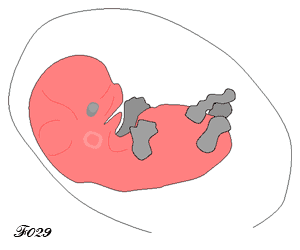 The precursor cells at the origin of neurons multiply in a particular area of the brain (in the ventricular zone of the neural tube), before migrating to their final location.
The precursor cells at the origin of neurons multiply in a particular area of the brain (in the ventricular zone of the neural tube), before migrating to their final location.
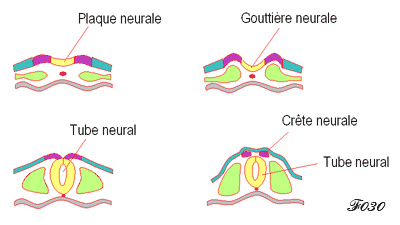 They then differentiate and emit extensions to connect to each other. Those which will not establish contact will die.
They then differentiate and emit extensions to connect to each other. Those which will not establish contact will die.
- 6° month : isolation of axons by myelin - The beginnings of REM sleep in the human being :
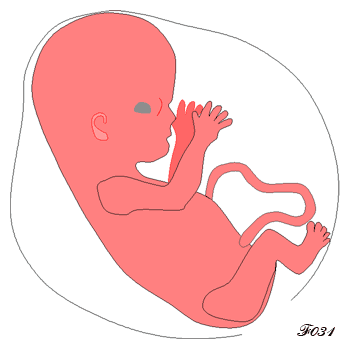
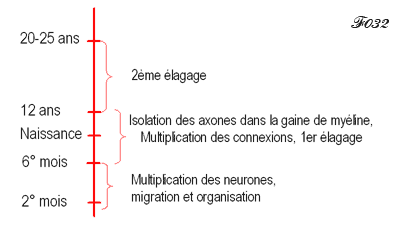 The brain has 90 billion neurons. The connections multiply. At the same time as they connect with the neighboring neurons, the axons begin to be covered with myelin. Thanks to this, they will be able to become functional and communicate efficiently with each other.
The brain has 90 billion neurons. The connections multiply. At the same time as they connect with the neighboring neurons, the axons begin to be covered with myelin. Thanks to this, they will be able to become functional and communicate efficiently with each other.
This process will continue after birth, until about 12 years of age, before giving way to a pruning process in which some connections are retained and strengthened and others are eliminated, showing the development of a learning process.
Above all, even before birth, the fetus seems to have REM sleep, a sign of the activation of genetic mechanisms ensuring the maturation of the brain so that it is functional from birth, i.e. capable of observing, understanding and assimilating all the functions that it will encounter in the outside world. These predefined instinctive programs will be suppressed during the progressive integration in the social domain: however, they will be preserved within the framework of the unconscious functioning of the brain and activated during REM sleep.
This pruning could coincide with the sidelining of the limbic system and the reinforcement of rational control leading to the loss of consciousness of a certain number of primitive functions. As a result, the dream, this imagery that escapes rational control, will only be able to appear during sleep when the control fades.
We can find this relationship between rational consciousness and the unconscious in a dream evoked in other conditions: the dream of the Chinese [cf : hypotheses]. In this dream, the usual behavior (limits cannot be crossed reasonably and the places or circumstances memorized impose to react according to the memory alone) is suddenly replaced by a spontaneous and irrational act (to observe and discover that the acquired memory does not conform to reality).
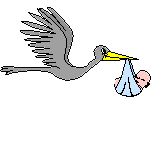 b – Développement du cerveau après la naissance :
b – Développement du cerveau après la naissance :
At birth, although it has 100 billion neurons, the brain is four times smaller than that of the adult, and only 10% of the neurons are connected to each other.
The two processes begun during the last months of pregnancy continue : the connections between neurons are increasingly numerous, while other cells, the oligodendrocytes, elaborate the myelin sheath that surrounds the axons of the central nervous system. This myelination, which is mainly responsible for the rapid increase in brain weight, will continue until the age of four.
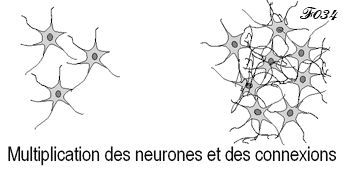
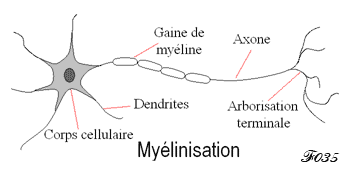 - 4° month : a maximum of connections can be observed in the visual cortex: the fifth sense is fully functional. Pruning will begin and continue until preschool age
- 4° month : a maximum of connections can be observed in the visual cortex: the fifth sense is fully functional. Pruning will begin and continue until preschool age
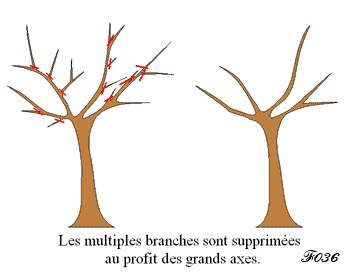 This mechanism already shows how the life and learning of the little man will develop. While most of the senses (touch, smell, taste, hearing) can be developed in utero, vision will only develop when light is introduced after birth.
This mechanism already shows how the life and learning of the little man will develop. While most of the senses (touch, smell, taste, hearing) can be developed in utero, vision will only develop when light is introduced after birth.
The environment plays a major role in the development of the senses and the resulting capacity for intelligent adaptation. Thus, the visual cortex will very quickly show its importance in the social domain, as it is linked to the recognition of faces, expressions and sign language.
Before this pruning, it is considered that genetic intelligence prevails. When pruning takes place, it eliminates useless knowledge, as connections related to non-existent situations are not retained.
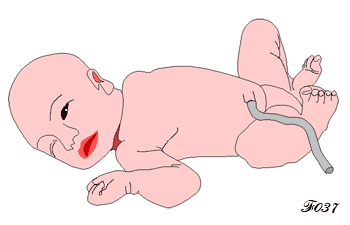 - 3 to 4 years : The 90% of connections that were not yet made at birth will be made through interactions with the environment, and according to the influences of the family, culture, education and society.
- 3 to 4 years : The 90% of connections that were not yet made at birth will be made through interactions with the environment, and according to the influences of the family, culture, education and society.
However, these transformations are not identical in all regions of the brain. In the medial prefrontal cortex, which is involved in higher cognitive functions, the maximum number of connections only occurs at around three to four years of age, and pruning is not noticeable until mid-adolescence.
It can therefore be seen that the brain reaches its optimal functions very quickly (at four months, the sense of vision is functional) in terms of its ability to interact with the environment. The medial prefrontal cortex, which is involved in cognitive control functions, reaches its maximum connections much later (at four years). This slower maturation is linked to the assimilation of more complex and often contradictory data.
The pruning, notable in the middle of adolescence, shows that it is at this turning point in development that social learning, an essential feature of the development of the little man, will become established.
The 3 - 4 year old stage may represent the moment when the brain ceases to develop naturally and gives way to social learning. Later, in adolescence, the final battle between the "natural" and instinctive mind and the "social" and reflective mind will be fought.
By conforming to the rules of the group, the adolescent will become an "adult".
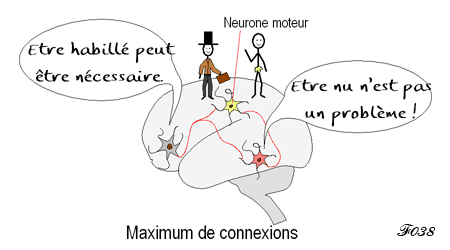
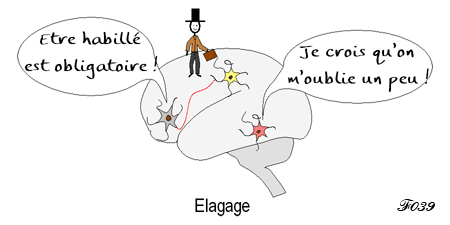 At this stage, we will have observed the successive development of two types of pruning:
At this stage, we will have observed the successive development of two types of pruning:
– a first pruning (perinatal) affected to the elimination of purely genetic connections. Adaptation is made to a new environment, more favourable than the one in which the DNA had appeared (the child is now protected by the mother).
- a second pruning(in the middle of adolescence) to eliminate the connections linked to individuality, favouring the integration of collective rules and self-control in order to conform to them [cf : the five ages of the brain].
- 1 year to six years :
Before the age of one, individual cells have established links with each other and formed functional regions.
From one to six years of age, more and more brain regions establish distant communication links : the brain society becomes organised.
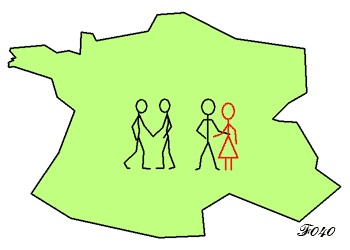
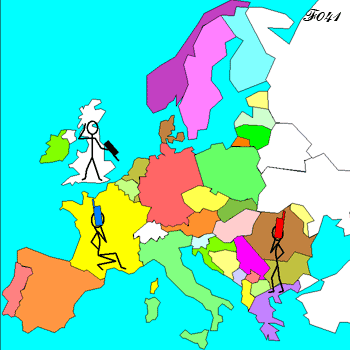
Some connections continue to disappear, while others are strengthened.
Thinning of the cortex begins in some areas (frontal cortex, sensory and motor cortex, visual cortex), while myelination continues.
By the age of six, the brain has grown almost fourfold and is 90% of its final size. We can therefore say that it has reached its functional size : now, learning will determine the connections between regions.
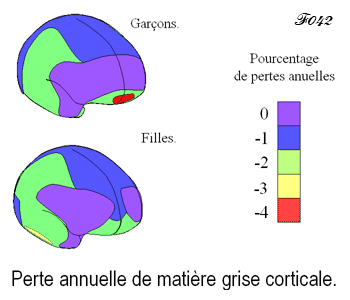
- 7 years : Learning has begun by removing unnecessary connections. It continues by strengthening distant connections and increasing the speed of nerve conduction in the axons. We have seen that these capacities are enabled by the myelination of axons.
The growth of the brain is a result of the increase in white matter (myelinated axons).
This is the "age of reason", as defined by Piaget: it marks that the links between nerve cells are privileged over the number of cells. This phenomenon can be observed in human societies: it is not the number of isolated individuals that makes a society strong, but the interactions between individuals that allow actions to be coordinated and optimised.
The volume of the basal ganglia (caudate nucleus) decreases as the child grows, which is interpreted as indicating greater efficiency in the motor functions they control (standing, walking, writing, etc.).
Interactions with the external environment are accompanied by an increase in memory capacity and greater emotional maturity. Anatomically, there is an increase in the volume of the hippocampus and the amygdala (temporal lobe).
c - Main stages in the development of the child's abilities and brain :
From birth to one year :
The child's vision becomes functional, and he begins to develop motor skills by imitating the gestures and expressions of those around him.
The language areas become active, and he shows numerical abilities.
At four months of age, the child knows that an object that has disappeared from sight continues to exist, but he or she looks for it where he or she first saw it.
- From one year to six years :
At around 18 months he is able to distinguish himself from others, and recognises himself in a mirror.
- From six to 12 years :
Maturation of the prefrontal cortex (seat of logic and behavioural control) continues.
The child begins to inhibit instinctive functioning.
- From age 12 to adulthood :
Information processing is no longer limited to objects, but to hypotheses and ideas.
The capacity for abstraction develops, and the adolescent begins to use hypothetical-deductive reasoning ("if", "then").
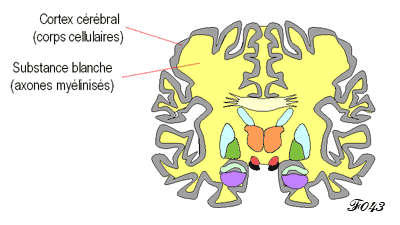 Progression of neuronal maturation in the cortex :
Progression of neuronal maturation in the cortex :
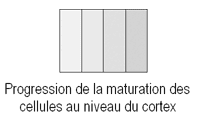 - From birth to one year :
- From birth to one year :
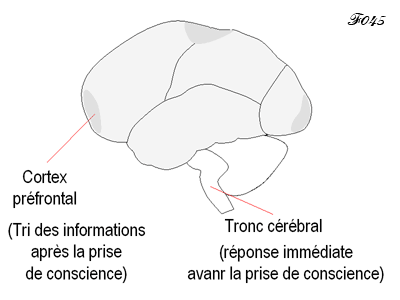 - From one year to six years :
- From one year to six years :
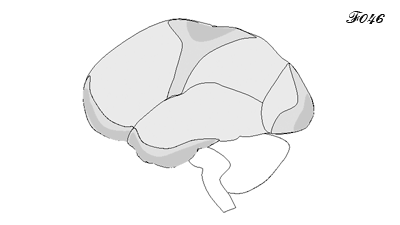 - From six to 12 years :
- From six to 12 years :
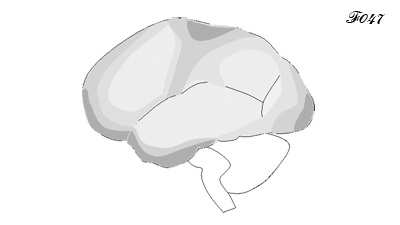 - From 12 years to adulthood :
- From 12 years to adulthood :
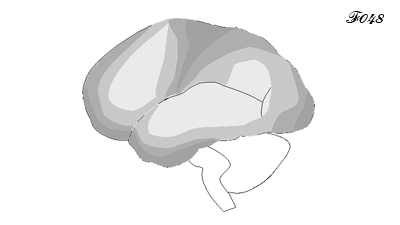 Myelin development in the white matter :
Myelin development in the white matter :
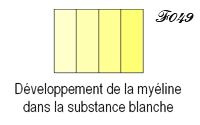 - Birth to one year :
- Birth to one year :
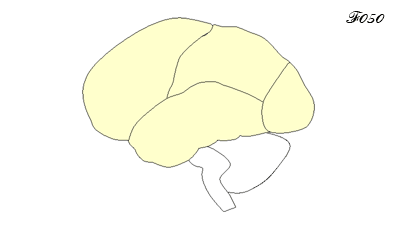 - One year to six years :
- One year to six years :
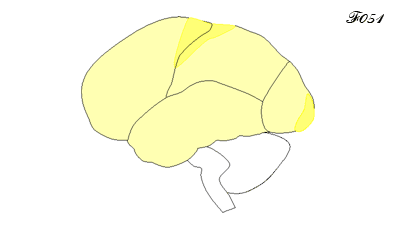 - Six years to 12 years :
- Six years to 12 years :
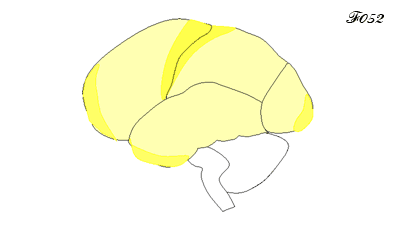 - 12 years to adulthood :
- 12 years to adulthood :
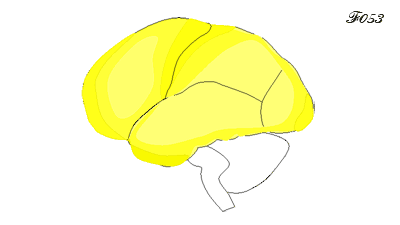
2 – Development of the child's abilities :
(continued)
Some may say that we are taking a long time to get into the realm of dreams.
But it is necessary to understand why our dreams escape us.. They are indeed the expression of an inner intelligence, of an instinctive thought which has the intuitive knowledge of what is good for us, but which our mind rejects, under the influence of collective rules.
On the other hand, couldn't the statement that "the kingdom of heaven belongs to children" [NdA] help us to find, through the study of the stages of development of the little man and his brain, elements of response to our research ?
While human beings, in their great majority, designate themselves as belonging to a superior species, if not a "chosen" species, even today, children are far from being recognized for their real capacities, when they are not simply treated as slaves. Ancient writings describing their status within the human community have sometimes frozen their place. The Bible has, in this sense, left its mark.
A boy is always a gift from God (Psalms 127.3), but the child possesses [cf : The child in the biblical world ], from birth, the defects of the adult human being : « Who can bring what is pure from the impure? No one ! » (Job 14.4).
For the sapiential authors, children must therefore be severely educated (Proverbs 13,24 ; 22,15 ; Sirach 30,1-13).
However, 2000 years ago, a man named Jesus of Nazareth expressed a new idea : children were no longer to be discarded. On the contrary, they were models to be imitated : « Let the little children come to me, and do not hinder them, for the kingdom of God belongs to such as these. » (Mark 10.14).
Today, scientists are discovering abilities in this child that, until then, no one would have dared to acknowledge.
What do we know about him, and what do we know about his intelligence ?
By what developmental processes does the little man manage to exercise it ?
1 - The beginnings of consciousness :
A – The development of the embryo and the fetus - the stages of gestation :
1st week : from this first week, two events occur. First of all the fertilization of the maternal ovocyte which will then migrate towards the uterus from the 1st to the 6th day; then, on the 7th day, the nidation of the egg on the uterine wall.

2nd week : development of the embryo.
From the 8th day, the embryo begins to organize itself, constituting two poles (head - tail).
Then, a cellular thickening appears on the dorsal face of the embryonic disc, the primitive line, which extends on the two thirds of its length. This line will determine the longitudinal axis of the embryo.
At the end of the second week, the symmetry of the embryo is achieved.
During the fourth week, the neural gutter, formed by the digging of the primitive line, closes, constituting the neural tube, at the origin of the nervous system.


The neural tube will then give birth to three primary vesicles (prosencephalon, mesencephalon, rhombencephalon) which will later divide into five secondary vesicles (telencephalon, diencephalon, mesencephalon, metencephalon and myelencephalon) at the origin of the brain and the medulla oblongata.


During the 5th week, excrescences appear on both sides of the body, outlines of the future members.

At the seventh week, one can distinguish the fingers of the hands, as well as the principal components of the face : eyes, eyelids, mouth, nose, and ears.

During the 2nd month, the production of neurons accelerates, reaching up to 5000 neurons per second.
At 2 months and a half : The cerebral hemispheres, derived from the telencephalon, are visible from the first ultrasound.

It is at this time that the brain shows signs of activity.
From the 8th week of development, the embryo is sufficiently developed to be called a fetus : at this stage, all the organ outlines are formed.
It measures approximately 35 mm and its first movements are visible on the ultrasound.
At the end of the 3rd month (12e semaine), the first measurable signs of electroencephalographic activity appear.
At the 5th month (20th week) the first auditory and tactile reactions reveal this nervous activity.
Although functional, the cortex is far from being completed. The connections between neurons (synapses) are in excess.
The spinal cord is becoming myelinated.
At the 6th month, the furrows and convolutions of the cerebral cortex appear. The growth cones of the neuronal axons move towards their target neuron, while the Schwann cells surround the axons with a myelin sheath.


During the 7th month, lthe sense organs develop and the movements become more coordinated : the nervous system is perfecting.
Once genetic development is complete, learning will determine which neurons will live or die. The connections that are not used will degenerate after birth. The brain will then lose a third of its 100 billion neurons.
Myelination, which is responsible for the rapid increase in brain weight, continues until the age of four.
B – The sensory universe of the fetus :
a – Its sound universe :The fetus grows in an environment where a multitude of noises reign permanently : first of all sounds of maternal origin such as gastrointestinal noises, the beating of the heart or breathing, the vibrations of the maternal vocal cords ; but also external noises : maternal voice and various sounds coming from the environment.
The background noise in which the fetus is immersed is around 30 to 60 dB SPL (Sound Pressure Level), which is close to our own level.
However, during the first weeks of gestation, these sounds have no impact, because the auditory system of the fetus is not sufficiently developed to be functional.
It is not until the 7th month (la 28e semaine) that the fetus begins to react to a loud external sound (a level equivalent to the sound of a jackhammer, i.e. 110 dB SPL), emitted near its mother.
It is during the eighth month that its hearing is refined and that its auditory system can differentiate between high and low sounds.
It is therefore only when the fetus is nearing term that it can hear external voices, provided that the sound level exceeds the 80 dB SPL corresponding to the voice of a comedian on stage.
Shortly before birth it hears frequencies between 1000 and 3000 Hertz for a sound level of 60 dB SPL.
b - His body :
Devoid of a cerebral nervous system and functional senses during the first months of development, the fetus is certainly not aware of its environment. The first thing that is put in place is its own body.
Indeed, from the first month it begins to move; these movements, of reflex origin, exercise its muscles and joints.
However, it is not until the third quarter (when his nervous system is sufficiently developed) that these movements become more coordinated.
For that, the vestibular system of the ear shows its importance. Consisting of a vestibule (sensitive to linear accelerations), and semicircular canals (sensitive to angular accelerations), this system is ready to function from the 32nd week: it allows the fetus to adapt its posture.


c - Smell :
Although its olfactory system (receptors and bulbs) is in place since the 8th week, the fetus starts to perceive the odorous molecules which arrive to him via the amniotic liquid only during the last months of gestation.
In fact, observations made in maternity wards had shown that the smell of the amniotic fluid of mothers who had eaten spicy food was very spicy.
These observations were confirmed in 2000, when an experiment conducted at the European Center of Taste Sciences (Dijon) by the team of Benoist Schaal and his collaborators, showed that a newborn whose mother had consumed aniseed during the last months of her pregnancy recognized this smell at birth and even showed signs of preference.
d - Sight :
The last sense to develop, sight is the sense that is least stimulated in the intrauterine environment.
During the 7th month, the eyelids open, the eyeballs move, but the visual system and in particular the development of the photo-receptor cells of the retina is incomplete.
In 1980, experiments carried out by Peleg and Goldman, during an amnioscopy, made it possible to observe that an illumination caused accelerations of the cardiac rhythm in the fetus. More recently, researchers from the University of Arkansas have also shown, by magnetoencephalography, that the fetus was sensitive to luminous fluxes when these were emitted outside the belly.
However, apart from variations in light intensity, it is very difficult to know what a fetus perceives in the maternal womb.
e - Memory :
If the physical development of the fetus is relatively easy to follow, its memory raises more questions. It seems to be established that we have no memory of our first two or three years of life and even more so of our fetal life : this is called infantile amnesia.
However, it has been observed that at the end of gestation the fetal brain memorizes elements of intrauterine life: maternal voice, smells, taste memories...
Moreover, clinical observation shows that in situations of major stress, adults can assume postures directly related to painful events suffered just after their birth : for example, a child who regularly plays hangman and whose anamnesis reveals that he was born with the umbilical cord around his neck.
Sensations experienced during the perinatal period would therefore have been memorized: they could resurface later in a totally different context.
Today, even if it is established that there are several cerebral structures involved in memory in the fetus, it is not certain that they are functional: this is what would explain infantile amnesia.
To understand this, it is necessary to know how a mature memory functions.
In adults, the information received by the brain is subjected to a double processing :
- a first very rapid processing, called analogical, during which the neurons put the information in memory, without classifying it. For this reason, they are difficult to recover in conscious processing.
 |
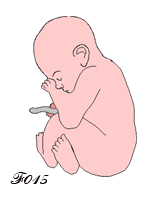 |
Analogical processing is that of the fetus or the infant.
The information is not listed.
The information is not listed.
- then, a second slower processing, qualified as cognitive, isolates the information from its context, then gives it a meaning, before storing it... It is this classification which makes it accessible to the consciousness.

Cognitive processing allows us to find the information.
Associations can then be found between various events or objects, as well as links deferred in time, allowing the recall of a past situation.
This processing requires the involvement of elements (prefrontal cortex, modulator neurons) that are not yet fully developed in the fetus and the newborn (the frontal cortex continues to mature until the age of four). The fetus can therefore begin to store analogical knowledge, but it is not yet ready to classify it cognitively, because it does not yet have access to the reality of the external world.
This hypothesis does not mean that there are no memories acquired during the fetal period, but these are reduced to diffuse sensations that the adult cannot access later in a controlled way.
What can happen if we imagine that these memories stored in analogy one day pass into cognitive mode and become accessible ?
In this case, the memory will be recalled, but it will remain excluded from its original context: it will be inserted into a new context, that of the life of the adult subject. It is then probable that the interpretation given to the memory will be false, because this memory will be reconstructed according to the subject's beliefs or the parents' story. This is the case of adults who are certain to have seen their mother dressed in a red shirt, even though the notion of color did not exist for them during the first hours of life.
Vision is formed by learning. Adults can evoke memories because they transpose them into the reality they have learned to recognize. But if these memories belong to the perinatal period, he will reconstruct them from his current knowledge or beliefs : thus, a cry heard during the foetal period, without being placed in the objective visual or tactile reality will be able to be integrated into a belief in invisible spirits, whose manifestations we can hear.

In the same way, in certain states of relaxation, the appearance of a visual image of a presence in a dark cave can be assimilated to the memory, either of the uterine life, or of a previous life, that of a prehistoric man for example.
It is also in this way that, by analogy with the transition from darkness to light experienced at birth, the "experience" of a subject near death (NDE) could be explained.
To be certain of recalling true memories, it is therefore necessary to focus on life events dating from a period when the cognitive processing of information was functional, which cannot be less than several semesters after birth.
C - Sleep and REM sleep :
During the first 6 months, the fetus sleeps almost all the time [cf : the sleep of the newborn] . During this period, its sleep presents phases of agitation and calm which follow one another without apparent logic. For this reason, we speak of "indeterminate" sleep.A change takes place during the 7th month (27 weeks): the very first signs of a "restless" sleep or seismic sleep, (the equivalent of our REM sleep), gradually appear in the fetus. Eye movements become rapid, while arms and legs become slightly agitated. During this sleep, the breathing rhythm is very irregular. The duration of this restless sleep will progressively increase until birth, participating in the development of nerve cells: this is called fetal construction sleep.
At 29 weeks, a new stage: at the end of the seventh month, a third phase of sleep is required, the calm sleep, equivalent to the slow wave sleep of the adult, during which the fetus moves very little..
During the eighth month, the three sleep phases - indeterminate, restless and calm - now follow each other in a regular 50-minute cycle. Thus, in the ninth month, restless sleep occupies about 65% of the time, calm sleep 25%, and indeterminate sleep 10%. By the way, we will notice that the sleep of the fetus is not influenced by the sleep-wake rhythm of the mother.

The sleep of the fetus.
SA : agitated sleep
SC : calm sleep
SL : slow wave sleep
SC : calm sleep
SL : slow wave sleep
It is shortly before birth that the fetus will start to wake up : it opens its eyes for the first time. After birth, by inserting itself into the alternation of day and night, its biological rhythms will be transformed (cf : The phases of sleep in adults).
If the cerebral activity of the fetus sleep includes a phase similar to the paradoxical sleep of the adult, can we affirm that the fetus dreams? As the fetus is not yet able to relate sounds and smells to real objects or events, it is unlikely that its brain produces images such as those of an adult during a dream. This would require a capacity for symbolic representation, which does not appear before the age of eight. However, we notice that his phase of agitated sleep (the equivalent of REM sleep during which dreams take place), occupies, shortly before the term, a very important part of his sleep.
One can imagine that this type of sleep serves to structure the movements which, later, during the REM sleep of the adult, will be inhibited.
On the other hand, in adults for whom the memorization of events and lived experiences is important, it is the duration of the slow wave sleep (equivalent of the calm sleep) which will be the most important: it is indeed during this slow wave sleep that the general memory will be organized.

The child's sleep :
E : falling asleep
SA : agitated sleep
SC : calm sleep
SL : slow wave sleep
SLL : light slow wave sleep
SLP : deep slow wave sleep
SP : REM sleep
S2 : stage 2 of slow wave sleep
S2 S3 : stages 2 and 3 of slow wave sleep
SA : agitated sleep
SC : calm sleep
SL : slow wave sleep
SLL : light slow wave sleep
SLP : deep slow wave sleep
SP : REM sleep
S2 : stage 2 of slow wave sleep
S2 S3 : stages 2 and 3 of slow wave sleep
D - Brain Development :
« Let the little children come to me ».Some phrases cross the centuries and still remain relevant today.
Why have they left such a mark on the imagination ? Do they conceal a truth that speaks to the hearts of men ?
If this is so, why is this truth so little heard ?
Our purpose today will be to understand why this sentence has a value that our rationality cannot dismiss, even though it has never really been able to grasp its meaning.

Thus, if we hear sounds, we will analyze them in a linguistic or musical way.


The predator has 3 possibilities: go around to the right or to the left, jump.

The hunter has 2 possibilities to shoot: standing or kneeling.
To understand intelligence, we can compare it to a computer assigned to specific tasks.
As a result, up to eight types of intelligence have been defined and assessed by intelligence quotient (IQ) tests.
However, while IQ tests are useful in psychology or job recruitment, their numerical results only indicate the number of questions that the interviewee answered correctly. We can learn more by observing how the subject approaches the questions.
Take the example of a child who, during a test, is asked the question: "You buy six apples at the market, you lose four on the way home. How many are left? ".
And who answers: "I can't lose four, because my father would punish me! ".
Is this answer wrong? Doesn't it rather show that there are two main types of intelligence, one linked to learning, and the other to sensitive perception.
Wouldn't intelligence be rather the capacity to adapt to any situation?
For a better understanding, we will therefore consider it under these two aspects: a conceptual intelligence (linked to thought contents separated from the reality of things) and a pragmatic intelligence (linked to the necessities of life).
Thus, in the preceding example, one will observe :
- under its intellectual aspect, a logical calculation which describes a virtual reality partially independent of the objective reality,


In man, this intelligence has for support the whole of his five senses [cf : L’édifice de la conscience].
Intelligence would thus be the capacity to listen and to analyze information, concrete or virtual, the final result being perceived pleasantly (one will then wish to use it) or unpleasantly (and in this case one will avoid it).
It can be useful to distinguish the different types of intelligence in order to study them better (cf: the eight intelligences). However, the set of characteristics that evolution has selected belongs to a "global intelligent system" that is indispensable both for the exercise of consciousness and for survival in a hostile environment.
In this sense, all living species are capable of "awareness", to detect food or the presence of predators.


This need to know, that we can qualify of "instinctive", is the one that we find from the beginning of the development of the intelligence, indissociable of the capacity of analysis, indissociable of the conscience which is also, in the man, the capacity to know that he exists in the environment.

To understand how the brain develops and to grasp the successive stages of its development is essential to approach the functioning of thought, and to determine how it has one day dissociated itself between rationality and sensibility.
a - Development of the brain during pregnancy :
- 2° month : organization of neurons :


- 6° month : isolation of axons by myelin - The beginnings of REM sleep in the human being :


This process will continue after birth, until about 12 years of age, before giving way to a pruning process in which some connections are retained and strengthened and others are eliminated, showing the development of a learning process.
Above all, even before birth, the fetus seems to have REM sleep, a sign of the activation of genetic mechanisms ensuring the maturation of the brain so that it is functional from birth, i.e. capable of observing, understanding and assimilating all the functions that it will encounter in the outside world. These predefined instinctive programs will be suppressed during the progressive integration in the social domain: however, they will be preserved within the framework of the unconscious functioning of the brain and activated during REM sleep.
This pruning could coincide with the sidelining of the limbic system and the reinforcement of rational control leading to the loss of consciousness of a certain number of primitive functions. As a result, the dream, this imagery that escapes rational control, will only be able to appear during sleep when the control fades.
We can find this relationship between rational consciousness and the unconscious in a dream evoked in other conditions: the dream of the Chinese [cf : hypotheses]. In this dream, the usual behavior (limits cannot be crossed reasonably and the places or circumstances memorized impose to react according to the memory alone) is suddenly replaced by a spontaneous and irrational act (to observe and discover that the acquired memory does not conform to reality).

At birth, although it has 100 billion neurons, the brain is four times smaller than that of the adult, and only 10% of the neurons are connected to each other.
The two processes begun during the last months of pregnancy continue : the connections between neurons are increasingly numerous, while other cells, the oligodendrocytes, elaborate the myelin sheath that surrounds the axons of the central nervous system. This myelination, which is mainly responsible for the rapid increase in brain weight, will continue until the age of four.



The environment plays a major role in the development of the senses and the resulting capacity for intelligent adaptation. Thus, the visual cortex will very quickly show its importance in the social domain, as it is linked to the recognition of faces, expressions and sign language.
Before this pruning, it is considered that genetic intelligence prevails. When pruning takes place, it eliminates useless knowledge, as connections related to non-existent situations are not retained.

However, these transformations are not identical in all regions of the brain. In the medial prefrontal cortex, which is involved in higher cognitive functions, the maximum number of connections only occurs at around three to four years of age, and pruning is not noticeable until mid-adolescence.
It can therefore be seen that the brain reaches its optimal functions very quickly (at four months, the sense of vision is functional) in terms of its ability to interact with the environment. The medial prefrontal cortex, which is involved in cognitive control functions, reaches its maximum connections much later (at four years). This slower maturation is linked to the assimilation of more complex and often contradictory data.
The pruning, notable in the middle of adolescence, shows that it is at this turning point in development that social learning, an essential feature of the development of the little man, will become established.
The 3 - 4 year old stage may represent the moment when the brain ceases to develop naturally and gives way to social learning. Later, in adolescence, the final battle between the "natural" and instinctive mind and the "social" and reflective mind will be fought.
By conforming to the rules of the group, the adolescent will become an "adult".


– a first pruning (perinatal) affected to the elimination of purely genetic connections. Adaptation is made to a new environment, more favourable than the one in which the DNA had appeared (the child is now protected by the mother).
- a second pruning(in the middle of adolescence) to eliminate the connections linked to individuality, favouring the integration of collective rules and self-control in order to conform to them [cf : the five ages of the brain].
- 1 year to six years :
Before the age of one, individual cells have established links with each other and formed functional regions.
From one to six years of age, more and more brain regions establish distant communication links : the brain society becomes organised.

Close connections.

Distant connections.
Some connections continue to disappear, while others are strengthened.
Thinning of the cortex begins in some areas (frontal cortex, sensory and motor cortex, visual cortex), while myelination continues.
By the age of six, the brain has grown almost fourfold and is 90% of its final size. We can therefore say that it has reached its functional size : now, learning will determine the connections between regions.

Annual loss of cortical grey matter.
- 7 years : Learning has begun by removing unnecessary connections. It continues by strengthening distant connections and increasing the speed of nerve conduction in the axons. We have seen that these capacities are enabled by the myelination of axons.
The growth of the brain is a result of the increase in white matter (myelinated axons).
This is the "age of reason", as defined by Piaget: it marks that the links between nerve cells are privileged over the number of cells. This phenomenon can be observed in human societies: it is not the number of isolated individuals that makes a society strong, but the interactions between individuals that allow actions to be coordinated and optimised.
The volume of the basal ganglia (caudate nucleus) decreases as the child grows, which is interpreted as indicating greater efficiency in the motor functions they control (standing, walking, writing, etc.).
Interactions with the external environment are accompanied by an increase in memory capacity and greater emotional maturity. Anatomically, there is an increase in the volume of the hippocampus and the amygdala (temporal lobe).
c - Main stages in the development of the child's abilities and brain :
From birth to one year :
The child's vision becomes functional, and he begins to develop motor skills by imitating the gestures and expressions of those around him.
The language areas become active, and he shows numerical abilities.
At four months of age, the child knows that an object that has disappeared from sight continues to exist, but he or she looks for it where he or she first saw it.
- From one year to six years :
At around 18 months he is able to distinguish himself from others, and recognises himself in a mirror.
- From six to 12 years :
Maturation of the prefrontal cortex (seat of logic and behavioural control) continues.
The child begins to inhibit instinctive functioning.
- From age 12 to adulthood :
Information processing is no longer limited to objects, but to hypotheses and ideas.
The capacity for abstraction develops, and the adolescent begins to use hypothetical-deductive reasoning ("if", "then").












